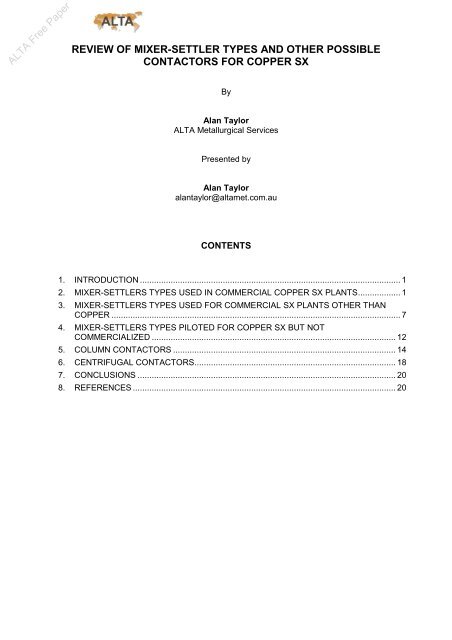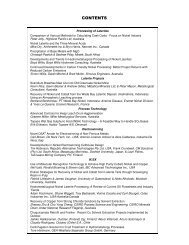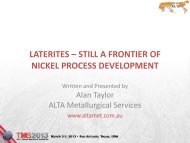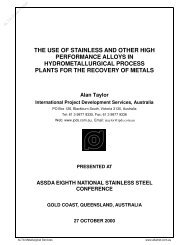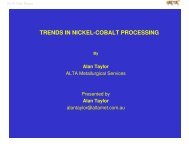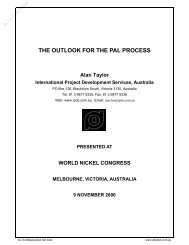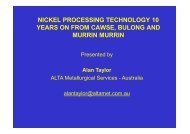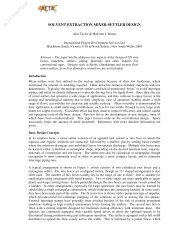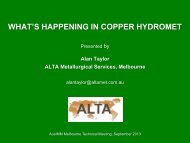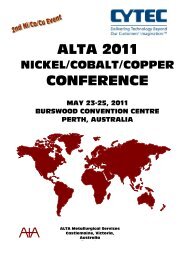review of mixer-settler types and other possible contactors for ...
review of mixer-settler types and other possible contactors for ...
review of mixer-settler types and other possible contactors for ...
You also want an ePaper? Increase the reach of your titles
YUMPU automatically turns print PDFs into web optimized ePapers that Google loves.
ALTA Free Paper<br />
REVIEW OF MIXER-SETTLER TYPES AND OTHER POSSIBLE<br />
CONTACTORS FOR COPPER SX<br />
By<br />
Alan Taylor<br />
ALTA Metallurgical Services<br />
Presented by<br />
Alan Taylor<br />
alantaylor@altamet.com.au<br />
CONTENTS<br />
1. INTRODUCTION .............................................................................................................. 1<br />
2. MIXER-SETTLERS TYPES USED IN COMMERCIAL COPPER SX PLANTS.................. 1<br />
3. MIXER-SETTLERS TYPES USED FOR COMMERCIAL SX PLANTS OTHER THAN<br />
COPPER .......................................................................................................................... 7<br />
4. MIXER-SETTLERS TYPES PILOTED FOR COPPER SX BUT NOT<br />
COMMERCIALIZED ....................................................................................................... 12<br />
5. COLUMN CONTACTORS .............................................................................................. 14<br />
6. CENTRIFUGAL CONTACTORS..................................................................................... 18<br />
7. CONCLUSIONS ............................................................................................................. 20<br />
8. REFERENCES ............................................................................................................... 20
ALTA Free Paper<br />
1. INTRODUCTION<br />
Historically the conventional <strong>mixer</strong>-<strong>settler</strong> has been the workhorse <strong>of</strong> copper solvent extraction (SX)<br />
operations. However, a number <strong>of</strong> <strong>other</strong> designs have been commercialized, <strong>and</strong> are gaining in<br />
popularity in recent years. These include:<br />
<br />
<br />
<br />
Krebs<br />
Reverse flow<br />
Outokumpu VSF<br />
Other <strong>mixer</strong>-<strong>settler</strong> designs which have been used commercially <strong>for</strong> applications outside <strong>of</strong> copper<br />
such as uranium include:<br />
<br />
<br />
<br />
<br />
CMS<br />
Lurgi<br />
IMI<br />
Kerr-McGee<br />
There have also been some <strong>mixer</strong>-<strong>settler</strong> designs which have been piloted but did not reach the<br />
commercial scale. Examples are:<br />
<br />
<br />
Circular Segmented<br />
Electrostatic<br />
Column <strong>and</strong> centrifugal <strong>contactors</strong> have not when found favour <strong>for</strong> copper, though they have been<br />
used <strong>for</strong> <strong>other</strong> applications such as such the separation <strong>and</strong> extraction <strong>of</strong> nickel-colbalt, uranium<br />
<strong>and</strong> zircinium-hafnium.<br />
<br />
<br />
<br />
<br />
Pulsed column<br />
Karr reciprocating plate column<br />
Oldshue-Rushton (Mixco) column<br />
Podbielniak centrifugal contactor<br />
2. MIXER-SETTLERS TYPES USED IN COMMERCIAL COPPER SX PLANTS<br />
Mixer-<strong>settler</strong>s were first utilised in the nuclear industry because <strong>of</strong> their low headroom, which<br />
minimized the amount <strong>of</strong> shielding required. Other attractive features included simplicity <strong>and</strong> low<br />
maintenance. Typically, the nuclear <strong>mixer</strong>-<strong>settler</strong>s consisted <strong>of</strong> partitioned “boxes” to avoid<br />
interstage piping, <strong>and</strong> relied on density differences to provide driving <strong>for</strong>ce <strong>for</strong> liquid flows. Based<br />
on this, they became a natural choice <strong>for</strong> SX circuits in uranium ore processing plants in the<br />
nineteen fifties <strong>and</strong> sixties followed by the initial copper SX plants in the late nineteen sixties <strong>and</strong><br />
early seventies. Since then the use <strong>of</strong> <strong>mixer</strong>-<strong>settler</strong>s has been st<strong>and</strong>ard practice <strong>for</strong> copper SX due<br />
to their simplicity, ease <strong>of</strong> operation, stability under a wide range <strong>of</strong> flows, accessibility <strong>for</strong> clean-out,<br />
reliable scale-up <strong>and</strong> suitability <strong>for</strong> very large scale plants. Consistent ef<strong>for</strong>t has been made to<br />
improve efficiency <strong>and</strong> reduce capital <strong>and</strong> operating costs <strong>for</strong> the basic design, which has led to the<br />
development <strong>of</strong> new designs.<br />
2.1. CONVENTIONAL MIXER-SETTLER<br />
Organic phases are contacted in mix boxes typically equipped with slow speed, large diameter, low<br />
shear pump-<strong>mixer</strong> type agitators, which provide interstage pumping as well as mixing. Pump<strong>mixer</strong>s<br />
commonly have variable speed drives, <strong>and</strong> are designed to avoid fine droplet <strong>for</strong>mation <strong>and</strong><br />
air entrainment which hinder coalescence in the <strong>settler</strong>s. Auxiliary mix boxes with agitators can be<br />
used <strong>for</strong> large plants to avoid mixing inefficiencies which can occur with large mix boxes, <strong>and</strong> to<br />
achieve a lower pr<strong>of</strong>ile.<br />
In the adjoining <strong>settler</strong>, the phases coalesce <strong>and</strong> separate by gravity, <strong>and</strong> are removed via separate<br />
weir boxes. The overall solution level is generally set by a fixed organic weir, while the depth <strong>of</strong> the<br />
top organic layer is set by an adjustable aqueous weir or by an adjustable sleeve on the discharge<br />
pipe in the aqueous weir box.<br />
1
ALTA Free Paper<br />
The mix boxes can be operated either with the organic or the aqueous as the continuous phase.<br />
Typically organic continuous is used <strong>for</strong> the final extraction <strong>and</strong> first stripping stages as it generally<br />
results in lower organic entrainment in the raffinate <strong>and</strong> strong electrolyte streams respectively.<br />
Aqueous continuous is commonly, though not exclusively, used <strong>for</strong> the <strong>other</strong> stages. An organic or<br />
recycle stream from the <strong>settler</strong>s back to the mix boxes is commonly incorporated to obtain <strong>and</strong><br />
maintain the operating phase ratio in the mix-boxes required <strong>for</strong> stable operation at the specified<br />
phase continuity.<br />
Mix boxes can be cylindrical or “square”; <strong>settler</strong>s are generally rectangular (though circular <strong>settler</strong>s<br />
have been used). Mix box retention times are typically 2-3 minute <strong>for</strong> extraction units, <strong>and</strong> 2<br />
minutes <strong>for</strong> strip units. Devices such as flow distributors, picket fences <strong>and</strong> various coalescence<br />
aids are installed in the <strong>settler</strong> to improve per<strong>for</strong>mance.<br />
Phase separation rates in the <strong>settler</strong>s are relatively slow, <strong>and</strong> the specific area is typically 3–5 m 3 /h<br />
(<strong>of</strong> combined aqueous <strong>and</strong> organic) per m 2 <strong>of</strong> <strong>settler</strong> area, depending on operating temperature,<br />
aqueous feed composition <strong>and</strong> concentration <strong>of</strong> extractant in the organic phase.<br />
Materials typically used include:<br />
<br />
<br />
<br />
<br />
<br />
Self supporting stainless steel (higher alloys considered <strong>for</strong> chloride levels > 1 g/L).<br />
Concrete lined with stainless steel (higher alloys considered <strong>for</strong> chloride levels > 1 g/L).<br />
Self supporting FRP.<br />
Concrete lined or coated with FRP.<br />
Concrete lined with HDPE.<br />
Covers are generally fitted <strong>for</strong> outdoor units to minimize organic evaporative losses, keep out dust<br />
<strong>and</strong> minimize heat loss.<br />
Extensive ongoing development work has been carried out on numerous aspects <strong>of</strong> the<br />
conventional <strong>mixer</strong>-<strong>settler</strong> to improve per<strong>for</strong>mance, <strong>and</strong> reduce capital <strong>and</strong> operating costs. These<br />
include:<br />
<br />
<br />
<br />
<br />
<br />
<br />
<br />
<br />
<br />
<br />
<br />
<br />
<br />
Mix box feed arrangements.<br />
Mix box anti-vortex baffles.<br />
Multiple mix boxes.<br />
Design <strong>of</strong> pump-<strong>mixer</strong>s <strong>and</strong> auxiliary agitators.<br />
Settler feed systems.<br />
Design, number <strong>and</strong> location <strong>of</strong> picket fences in the <strong>settler</strong>.<br />
In-<strong>settler</strong> baffles to accelerate coalescence <strong>and</strong> reduce entrainment.<br />
In-<strong>settler</strong> packing to accelerate coalescence <strong>and</strong> reduce entrainment.<br />
Settler configuration including depth <strong>and</strong> floor slope.<br />
Settler design velocities.<br />
Design <strong>of</strong> <strong>settler</strong> discharge weirs to minimize turbulence.<br />
Design <strong>of</strong> <strong>settler</strong> weir boxes <strong>and</strong> recycle systems.<br />
Settler crud removal systems.<br />
Figure 1 shows a typical two mix box arrangement set up <strong>for</strong> aqueous phase recycle.<br />
2
ALTA Free Paper<br />
Fig.1: Conventional Mixer-Settler Elevation <strong>and</strong> Plan Views<br />
Advantages include:<br />
Relatively simple low cost design.<br />
Generally stable, robust <strong>and</strong> predictable operation.<br />
Low maintenance.<br />
Reliable scale-up from small scale test units.<br />
Can h<strong>and</strong>le a wide range <strong>of</strong> flow rates <strong>and</strong> large turn down.<br />
Self regulating pump-<strong>mixer</strong>s avoid need <strong>for</strong> interstage level control.<br />
Relatively good visibility <strong>of</strong> the process <strong>for</strong> operators.<br />
Relatively simple to control pH <strong>and</strong> <strong>other</strong> operating conditions in the various stages.<br />
Easy access <strong>for</strong> crud removal.<br />
Low pr<strong>of</strong>ile means low solution pump heads <strong>and</strong> minimizes ro<strong>of</strong> heights <strong>for</strong> indoor construction.<br />
Disadvantages include:<br />
Large <strong>settler</strong>s needed to separate organic <strong>and</strong> aqueous between stages.<br />
Large footprint area.<br />
Large organic inventory.<br />
Lengthy piping runs due to mix boxes being located at alternative ends <strong>of</strong> <strong>settler</strong>s.<br />
3
ALTA Free Paper<br />
Large diameter interstage piping needed to minimize pressure drop because <strong>of</strong> limited head<br />
generated by pump-<strong>mixer</strong>s.<br />
Crud tends to collect in <strong>settler</strong>s, requiring periodic removal to avoid process upsets.<br />
Not suitable <strong>for</strong> systems with a large number <strong>of</strong> stages.<br />
2.2. KREBS MIXER-SETTLER<br />
Developed by Krebs in France in the nineteen seventies, <strong>and</strong> subsequently installed in numerous<br />
uranium <strong>and</strong> a fewer number <strong>of</strong> copper SX plants including the initial Olympic Dam operation in<br />
South Australia which came on stream in 1993. (The later expansion used conventional <strong>mixer</strong><strong>settler</strong>s<br />
<strong>for</strong> copper SX.)<br />
Like the conventional <strong>mixer</strong>-<strong>settler</strong>, there can be one or more mix boxes per stage depending on the<br />
solution flow rates <strong>and</strong> the required retention time. For a single box, the agitator is fitted with a low<br />
head, high volume, low shear conical pump, consisting <strong>of</strong> a static tulip shaped stator <strong>and</strong> a<br />
trapezoidal, typically six bladed, rotor. This is used to develop the head to lift the dispersion up to<br />
the pre-separation launder positioned above the <strong>settler</strong>. If two mix boxes are used, the first is<br />
equipped with a pump-mix type agitator, similar to the conventional <strong>mixer</strong>-<strong>settler</strong>, but designed <strong>for</strong><br />
less head generation because <strong>of</strong> the adjoining conical pump.<br />
Typically the primary separation <strong>of</strong> the organic <strong>and</strong> aqueous phases is 90% complete at the<br />
discharge <strong>of</strong> the upper launder, which enables the phases to be directed separately to the main<br />
<strong>settler</strong> below, entering via a baffle system. The organic <strong>and</strong> aqueous discharge weir boxes <strong>and</strong><br />
weirs are similar to the conventional design.<br />
Materials <strong>of</strong> construction options are similar to the conventional design. However, because <strong>of</strong> its<br />
smaller size, there is greater opportunity <strong>for</strong> shop fabrication <strong>and</strong> transport to site. The unit is totally<br />
covered to keep dust out <strong>and</strong> minimize organic evaporative losses.<br />
Fiure 2 illustrates a Krebs <strong>mixer</strong>-<strong>settler</strong> with two mix boxes, arranged <strong>for</strong> organic phase recycle<br />
Fig. 2: Krebs Mixer-Settler Elevation View<br />
Table 1 presents an economic comparison with the conventional <strong>mixer</strong>-<strong>settler</strong> taken from from<br />
‘Krebs <strong>and</strong> Solvent Extraction” by Roger Williams <strong>and</strong> Alain Sonntag presented at the ALTA<br />
Copper Hydrometallurgy Forum 1995.<br />
4
ALTA Free Paper<br />
Characteristics<br />
KREBS<br />
CONVENTIONAL<br />
Typical <strong>settler</strong> specific flow m 3 /h/m 2 8-12 3 - 5<br />
Relative solvent inventory 1 1.3 – 1.5<br />
Organic entrainment losses ppm 30 – 100 30 - 100<br />
Relative Capital Costs<br />
Equipment ex works 1<br />
1 – 1.2<br />
(depending on size)<br />
Transportation/Erection 1 1.3 – 1.5<br />
Piping/Cables 1 1.3<br />
Civil work – outdoor<br />
– indoor<br />
1<br />
1<br />
1.2<br />
1.8-2<br />
Table 1: Comparison <strong>of</strong> Krebs with Conventional Design*<br />
*Notes: 1. Some operations have reported higher organic entrainment losses <strong>for</strong> Krebs.<br />
2. License fee <strong>for</strong> Krebs design must be taken into account in the capex comparison.<br />
Advantages include:<br />
<br />
<br />
<br />
<br />
<br />
<br />
<br />
<br />
<br />
Smaller footprint area.<br />
Smaller building <strong>for</strong> indoor plants.<br />
Simplified plant layout.<br />
All piping at one end<br />
Shorter interstage <strong>and</strong> recycle piping.<br />
Fewer pipe trenches needed <strong>for</strong> large plants.<br />
Reduced instrumentation <strong>and</strong> electric cabling runs.<br />
More convenient layout <strong>for</strong> operators.<br />
Lower capex.<br />
Disadvantages include:<br />
<br />
<br />
<br />
<br />
<br />
Top launder limits access <strong>for</strong> crud removal <strong>and</strong> maintenance.<br />
More difficult <strong>for</strong> operators to visibly monitor internal operating conditions.<br />
The pumping function introduces additional power consumption.<br />
Some operations have reported higher than predicted organic entrainment, said to be due to the<br />
conical pump.<br />
Proprietary design subject to licence fee.<br />
2.3. REVERSE FLOW MIXER-SETTLER<br />
The reverse flow concept is being increasingly used in large scale copper, nickel/cobalt <strong>and</strong> zinc SX<br />
operations since the mid-nineteen nineties. It is now available through a number <strong>of</strong> engineering<br />
firms as an alternative to conventional <strong>mixer</strong>-<strong>settler</strong>s.<br />
The main difference from the conventional <strong>mixer</strong>-<strong>settler</strong> is the use <strong>of</strong> a side mounted launder to<br />
direct the dispersion from the mix boxes to the opposite end <strong>of</strong> the <strong>settler</strong> via turning vanes which<br />
redirect the flow across the width <strong>of</strong> the <strong>settler</strong>. The mix boxes <strong>and</strong> <strong>settler</strong> are essentially same as<br />
conventional units.<br />
Figure 3 shows a plan view schematic <strong>of</strong> the reverse flow concept.<br />
5
ALTA Free Paper<br />
Fig. 3: Plan View <strong>of</strong> Reverse Flow Mixer-Settler<br />
Advantages include:<br />
<br />
<br />
<br />
<br />
<br />
The discharge weirs, piping <strong>and</strong> valves are all at one end, thus gaining similar advantages to the<br />
Krebs design over the conventional design.<br />
Some phase separation occurs in the launder.<br />
Provides <strong>for</strong> distribution <strong>of</strong> the dispersion across the <strong>settler</strong> width.<br />
Has similar access <strong>and</strong> operator viewing advantages as conventional design.<br />
Offers some capex advantage over conventional <strong>mixer</strong>-<strong>settler</strong>s.<br />
Disadvantages include:<br />
<br />
<br />
Larger foot print, larger organic inventory <strong>and</strong> longer interstage piping than the Krebs design.<br />
Similar size based disadvantages as the conventionl design.<br />
2.4. VSF (VERTICAL SMOOTH FLOW) MIXER-SETTLER<br />
Proprietary <strong>mixer</strong>-<strong>settler</strong> design developed by Outokumpu. It originated in the nineteen seventies in<br />
the Kokkola cobalt plant in Finl<strong>and</strong>, <strong>and</strong> has been adopted <strong>for</strong> a growing number <strong>of</strong> large scale<br />
copper SX projects since 1995.<br />
Mixing <strong>and</strong> pumping actions <strong>of</strong> the conventional pump-<strong>mixer</strong> are split between a DOP pumping<br />
impeller <strong>and</strong> one or more double helix SPIROK <strong>mixer</strong>s which provide relatively low shear agitation.<br />
The dispersion enters the <strong>settler</strong> via a central vertical uptake <strong>and</strong> flows through a primary<br />
distributing fence, followed by two sets <strong>of</strong> non-jetting picket fences. The <strong>settler</strong> depth gradually<br />
increases towards the weir boxes at the discharge end to decrease velocities <strong>and</strong> reduce<br />
entrainment.<br />
If aqueous recycle is required, it is taken from a header located part way down the length <strong>of</strong> the<br />
<strong>settler</strong>. Organic recycle is taken from the side <strong>of</strong> the organic weir box.<br />
Figure 4 shows a schematic with two mix boxes as well as the DOP bpx.<br />
6
ALTA Free Paper<br />
Fig. 4: Schematic <strong>of</strong> VSF Mixer-Settler<br />
Advantages include:<br />
Reduced entrainment due to low shear, uni<strong>for</strong>m drop size, <strong>and</strong> the deep <strong>settler</strong> discharge end.<br />
Reduced crud <strong>for</strong>mation due to gentler mixing.<br />
High stage efficiency.<br />
Suitability <strong>for</strong> very large capacity units.<br />
Disadvantages include:<br />
Higher capex than conventional <strong>mixer</strong>-<strong>settler</strong>s.<br />
Similar size based disadvantages as the conventionl design.<br />
License fee payable.<br />
3. MIXER-SETTLERS TYPES USED FOR COMMERCIAL SX PLANTS OTHER THAN COPPER<br />
A variety <strong>of</strong> alternative <strong>mixer</strong>-<strong>settler</strong> designs have been developed <strong>and</strong> commercially applied in noncopper<br />
applications such as uranium extraction. These include:<br />
3.1. COMBINED MIXER-SETTLER (CMS)<br />
Developed by Davy Mckee (now Aker Kvaerner) in Engl<strong>and</strong> in the late nineteen seventies, <strong>and</strong><br />
subsequently installed at two commercial uranium plants <strong>for</strong> JCI in South Africa which came on<br />
stream in the early nineteen eighties.<br />
Mixing <strong>and</strong> phase separation are carried out in one vessel. During operation there are 3 zones:<br />
<br />
<br />
<br />
upper zone comprising the separated organic phase.<br />
lower zone comprising the separated phase.<br />
central zone comprising the dispersion.<br />
7
ALTA Free Paper<br />
The O:A ratio within the dispersion is controlled by adjusting the heights <strong>of</strong> the aqueous <strong>and</strong> organic<br />
discharge weirs, <strong>and</strong> is independent <strong>of</strong> the overall organic <strong>and</strong> aqueous feed solution ratio. No<br />
recycle <strong>of</strong> either phase is needed.<br />
The elimination <strong>of</strong> recycle reduces the combined solution flow through the unit compared with a<br />
conventional <strong>mixer</strong>-<strong>settler</strong> <strong>and</strong> <strong>other</strong> designs involving separate mix boxes <strong>and</strong> <strong>settler</strong>s. This means<br />
that the area required <strong>for</strong> phase disengagement is reduced.<br />
CMS units were only used <strong>for</strong> the extraction circuit in the two commercial plants, as the economic<br />
benefit was much less <strong>for</strong> the much smaller scrub, strip <strong>and</strong> regeneration <strong>mixer</strong>-<strong>settler</strong>s.<br />
Up to 300 pm <strong>of</strong> solids in the aqueous feed solution can be accommodated which eliminates the<br />
need <strong>for</strong> feed clarification equipment. A self regulating layer <strong>of</strong> crud <strong>for</strong>ms which acts as a ‘filter”,<br />
<strong>and</strong> reduces the organic entrainment in the raffinate. Intermittent surges <strong>of</strong> very high solids can<br />
also be tolerated, in which case crud can be readily tapped <strong>of</strong>f.<br />
The organic entrainment tends to be larger than <strong>for</strong> conventional <strong>mixer</strong>-<strong>settler</strong>s, in the range <strong>of</strong> 200-<br />
400 ppm compared with about 200 <strong>for</strong> conventional <strong>mixer</strong>-<strong>settler</strong>s in uranium applications, <strong>and</strong><br />
organic recovery equipment is normally used such as flotation or filtration systems.<br />
Figure 5 illustrates the CMS concept.<br />
Fig. 5: Elevation View <strong>of</strong> CMS Concept<br />
Table 2 presents a capex comparison with a conventional plant taken from “The Combined Mixer-<br />
Settler: A New Development in Solvent Extraction”, by CF Bonney <strong>and</strong> GR Rowden, presented at<br />
the 110th AIMI Annual Meeting, Chicago, 1981”.<br />
Table 2: Comparison <strong>of</strong> CMS Plant with Conventional Mixer-Settler Plant*<br />
*Note: License fee <strong>for</strong> CMS design must be taken into account in the capex comparison.<br />
8
ALTA Free Paper<br />
Advantages include:<br />
<br />
<br />
<br />
<br />
<br />
<br />
<br />
<br />
<br />
<br />
<br />
<br />
<br />
Much Smaller footprint area.<br />
Lower capex.<br />
Smaller building <strong>for</strong> indoor plants.<br />
Simplified plant layout.<br />
Can be totally enclosed.<br />
Short interstage piping; no recycle piping; no trenches<br />
Pump-mix agitators <strong>for</strong> CMS units are lower head <strong>and</strong> lower speed than the conventional design.<br />
Reduced instrumentation <strong>and</strong> electric cabling runs.<br />
More convenient layout <strong>for</strong> operators.<br />
Can h<strong>and</strong>le unclarified feed solutions.<br />
Self regulating crud layer.<br />
Not sensitive to changes in feed solution flow rates.<br />
Can cope with intermittent surges <strong>of</strong> very high solids in the feed solution.<br />
Disadvantages include:<br />
<br />
<br />
<br />
<br />
Higher organic entrainment requires organic recovery equipment.<br />
Only applied to uranium extraction circuit as yet.<br />
Area advantage is reduced as overall solution O:A ratio approaches 1:1. There<strong>for</strong>e would likely<br />
be more applicable to copper stripping than extraction.<br />
Proprietary design subject to licence fee.<br />
3.2. LURGI MIXER-SETTLER<br />
Developed by Lurgi in Germany. It was used at 3 commercial uranium plants in South Africa. The<br />
President Br<strong>and</strong> plant shown above.<br />
Involves multiple trays (5-20) in the <strong>settler</strong>, fed by distributor, to enhance the coalescence rate.<br />
Coalescence <strong>and</strong> separation occurs on each tray.<br />
The footprint area is typically 15-40% <strong>of</strong> conventional <strong>mixer</strong>-<strong>settler</strong> design. Capex is lower than<br />
conventional, though dependent on materials used. Tends to have higher organic entrainment than<br />
the conventional design, <strong>and</strong> requires a coalescer to reduce entrainment losses.<br />
Figure 6 shows a view <strong>of</strong> the instllation at the President Br<strong>and</strong> uranium plant in South Africa.<br />
Fig.6: Lurgi Mixer-Settler at President Br<strong>and</strong><br />
9
ALTA Free Paper<br />
3.3. IMI MIXER-SETTLER<br />
Developed by Israeli Mining Industries (IMI), Haifa, Israel, in the late nineteen sixties, <strong>and</strong><br />
commercially applied at Western Deep Levels uranium plant in South Africa. It is currently available<br />
through the Bateman Group.<br />
The mix box is equipped with a mixing impeller plus a pumping axial flow impeller shrouded in a<br />
draft tube which lifts the dispersion to a collecting launder. The dispersion is fed to the centre <strong>of</strong> a<br />
cylindrical <strong>settler</strong>, enters via a distributor, <strong>and</strong> flows radially outwards.<br />
The separated organic phases discharge via a top perypheral launder, while the aqueous leaves via<br />
a bottom channel fitted around most <strong>of</strong> peryphery. Baffles are fitted in the <strong>settler</strong> to reduce<br />
turbulence <strong>and</strong> promote coalescence.<br />
Figure 7 illustrates the the IMI concept.<br />
Fig. 7: Elevation View <strong>of</strong> IMI Mixer-Settler<br />
IMI claimed 50% reduction in <strong>settler</strong> area, 30% reduction in footprint area <strong>and</strong> 33% lower capex<br />
compared with conventional <strong>mixer</strong>-<strong>settler</strong>s, as shown in Table 3, prepared by IMI in 1967.<br />
Table 3: Comparison <strong>of</strong> IMI System with Conventional Mixer-Settler System<br />
Advantages include:<br />
<br />
<br />
<br />
<br />
<br />
Low velocity at periphery helps to improve phase separation, minimise velocity at the discharge<br />
weirs <strong>and</strong> reduce entrainment losses.<br />
Flexibility to optimize plant layout <strong>and</strong> minimise piping runs.<br />
Smaller <strong>settler</strong> area.<br />
Reduced plant footprint.<br />
Lower capex compared with conventional units.<br />
10
ALTA Free Paper<br />
Disadvantages include:<br />
<br />
<br />
Needs careful distribution to ensure even distribution in <strong>settler</strong> (<strong>other</strong>s found this difficult to<br />
achieve with this type <strong>of</strong> design).<br />
Additional power needed <strong>for</strong> pumping impeller.<br />
3.4. KERMAC MIXER-SETTLER<br />
Installed at Kerr-McGee’s Grant’s operation in New Mexico in 1958.<br />
with the mix box located at the centre.<br />
Utilized a cylindrical <strong>settler</strong><br />
In extraction, aqueous flows through the circuit by gravity, <strong>and</strong> is discharged from each <strong>settler</strong> via 4<br />
jacklegs. Organic is pumped to each mix box <strong>and</strong> overflows via a perypheral launder, with a recycle<br />
pipe provided back to the mix box.<br />
At Grants, the extraction mix boxes were 8ft diameter by 9.5 ft high in stainless steel, while the<br />
<strong>settler</strong>s were 40 ft diameter by 9 ft high in wood. The strip <strong>mixer</strong>-<strong>settler</strong>s were similar but smaller.<br />
Figure 8 illustrates the Kermac concept.<br />
3.5. IN-LINE MIXER SYSTEM<br />
Fig. 8: Elevation View <strong>of</strong> Kermac Mixer-Setller<br />
Developed in late nineteen seventies by Kenics Corp, Massachusetts. An 11.4 m 3 /h pilot plant<br />
operated at Kerr-McGee uranium ore treatment operation at Grants, New Mexico in 1978.<br />
It was then proposed <strong>for</strong> a number <strong>of</strong> <strong>other</strong> uranium processing projects, <strong>and</strong> was adopted <strong>for</strong> the<br />
Earth Sciences’ commercial uranium from phosphoric acid operation at Calgary, Canada, in 1980.<br />
It consists <strong>of</strong> a Kenics static <strong>mixer</strong> followed by a baffled cylindrical settling vessel. The baffles serve<br />
to reduce the risk <strong>of</strong> flooding <strong>and</strong> to reduce entrainment. They are typically located in the dispersion<br />
zone downstream <strong>of</strong> the entrance zone where there is turbulence <strong>and</strong> back mixing.<br />
The organic flow is pumped from stage to stage, while the aqueous flows under gravity. Organic<br />
recycle is achieved using a split from the organic pump discharge.<br />
Crud can be removed from just below the interface by periodically opening valves on the side wall<br />
<strong>and</strong> discharge end <strong>of</strong> the <strong>settler</strong>.<br />
Viewing “windows” are fitted into the <strong>settler</strong> wall <strong>for</strong> level control purposes.<br />
In 2002, Koch-Otto York in the USA piloted a similar concept – “Plant in a Pipe”, <strong>and</strong> installed a four<br />
stage (2 extraction,1 scrub, 1 strip) demonstration plant <strong>for</strong> copper recovery at the Phelps Dodge<br />
Morenci operation in 2002 to treat 22.7 m3/h <strong>of</strong> aqueous feed solution. The Koch-Otto York system<br />
incorporates a reactor between the <strong>mixer</strong> <strong>and</strong> the <strong>settler</strong> to provide additional contact time. The<br />
required contact time <strong>for</strong> copper extraction is higher than that <strong>for</strong> uranium.<br />
Fig. 9 illustrates the Kenics system.<br />
11
ALTA Free Paper<br />
Fig. 9: Schematic <strong>of</strong> Kenics In-Line Mixer System<br />
Advantages include:<br />
<br />
<br />
<br />
<br />
<br />
<br />
<br />
<br />
<br />
Totally enclosed system, which excludes dust, minimizes evaporative losses, improves fire<br />
protection <strong>and</strong> excludes air.<br />
Narrow droplet size distribution due to static <strong>mixer</strong>, which leads to rapid phase disengagement in<br />
<strong>settler</strong>.<br />
Plug flow <strong>mixer</strong>; no back mixing<br />
Low organic entrainment; Kenics claimed 10 ppm.<br />
Lower foot print area.<br />
Smaller organic inventory than conventional <strong>mixer</strong>-<strong>settler</strong> design.<br />
Lower capex than conventional design.<br />
Now moving parts except pumps, low maintenance.<br />
Simple construction; facilitates use <strong>of</strong> plastics.<br />
Disadvantages include:<br />
<br />
<br />
<br />
<br />
<br />
Use <strong>of</strong> interstage organic pumps, which make flow control through the system more complex,<br />
<strong>and</strong> risks affecting phase disengagement through air entrainment <strong>and</strong> <strong>possible</strong> fine haze<br />
<strong>for</strong>mation.<br />
Interface level control more challenging than conventional settles. Visibility through windows may<br />
deteriorate.<br />
Overall operation more complex than conventional plant, <strong>and</strong> more dependant on<br />
instrumentation.<br />
Turn down in feed flow limited to about 30%, after which efficiency falls away.<br />
Limited access removes excessive crud accumulation.<br />
4. MIXER-SETTLERS TYPES PILOTED FOR COPPER SX BUT NOT COMMERCIALIZED<br />
A number <strong>of</strong> <strong>other</strong> novel <strong>mixer</strong>-<strong>settler</strong> designs have been developed <strong>for</strong> copper SX <strong>and</strong> tested at<br />
pilot plant scale without finding application in commercial plants. Examples include:<br />
12
ALTA Free Paper<br />
4.1 SEGMENTED CIRCULAR MIXER-SETTLER<br />
Developed by Davy Mckee (now Aker Kvaerner) in Engl<strong>and</strong> <strong>and</strong> patented in 1974. It has a<br />
conventional mix box at the centre <strong>of</strong> a relatively small cylindrical <strong>settler</strong>. As the mixed phase<br />
leaves the mix box <strong>and</strong> enters the <strong>settler</strong> it passes through pads <strong>of</strong> a dual media <strong>of</strong> knitted metal<br />
<strong>and</strong> plastic (DC Knitmesh supplied by KnitMesh Ltd) to accelerate coalescence. Periodic cleaning<br />
<strong>of</strong> the pads is necessary to remove accumulated solids <strong>and</strong> crud if present. Pilot plant tests were<br />
carried out in Zambia, Zaire <strong>and</strong> Chile, <strong>and</strong> demonstration tests were carried out at S.E.C.<br />
Corporation in Texas. Cost comparisons with conventional <strong>mixer</strong>-<strong>settler</strong>s indicated an installed cost<br />
saving <strong>of</strong> 30-35% <strong>and</strong> a solvent inventory saving <strong>of</strong> 30-40%. He perceived problem <strong>of</strong> plugging has<br />
hindered it’s progress to commercial application.<br />
Advantages<br />
<br />
<br />
<br />
<br />
<br />
Compact design, area 25% <strong>of</strong> conventional <strong>settler</strong>.<br />
Reduced capital.<br />
Fabrication in FRP or <strong>other</strong> materials.<br />
Reduced construction time.<br />
Reduced fire risk due to fully sealed units.<br />
Disadvantages<br />
Potential blockage <strong>of</strong> pads if crud <strong>for</strong>mation or feed solids is excessive.<br />
Potential high cleaning frequency in dirty feed systems.<br />
Entrainment losses same as conventional plant.<br />
Proprietary design subject to licence fee.<br />
The design is illustrated in Fig. 10.<br />
Fig. 10: Segmented Circular Mixer-Settler<br />
13
ALTA Free Paper<br />
4.2 ELECTROSTATIC MIXER-SETTLER<br />
Developed by CE Natco in the nineteen seventies <strong>for</strong> copper SX. In the mixing step, an emulsion is<br />
deliberately created which improves mass transfer. The <strong>settler</strong> involves the combination <strong>of</strong><br />
electrostatic <strong>and</strong> centrifugal <strong>for</strong>ces in an electrically charged hydrocyclone. The resulting cyclone<br />
underflow contains aqueous droplets <strong>of</strong> in excess <strong>of</strong> 1 cm diameter. The coalescence rate is said<br />
to be 10 times faster than with a conventional <strong>mixer</strong>-<strong>settler</strong>. The raffinate <strong>and</strong> strong electrolyte<br />
streams are passed through CE Natco OSX multi-media coalescers to obtain very low organic<br />
entrainments levels. A skid mounted portable pilot plant was tested at Ranchers <strong>and</strong> Cities Service<br />
SX plants in Arizona. Each contactor stage comprised a throttled centrifugal pump <strong>for</strong> mixing <strong>and</strong><br />
pumping, a retention column allowing 1 minute reaction time <strong>and</strong> an electrostatic separator column.<br />
Average extraction efficiency was 95% <strong>and</strong> the <strong>settler</strong> loading rate was 25 gpm/ft 2 . Commercial<br />
quotes were submitted <strong>for</strong> various projects but the cost advantage over conventional <strong>mixer</strong>-<strong>settler</strong>s<br />
was not considered to be sufficient.<br />
Advantages<br />
High mixing efficiency.<br />
Smaller footprint <strong>and</strong> lower organic inventory.<br />
Reduces organic vapor loss.<br />
Allows lighter diluents to be used.<br />
Reduces SX contamination by airborne materials.<br />
Reduces interfave sludge build-up.<br />
Improved safety.<br />
Reduced fire hazard.<br />
High specific settling rate <strong>of</strong> 25 gpm/ft 2 .<br />
Disadvantages<br />
Relies on coalescers to achieve low organic entrainment levels.<br />
Insufficient cost advantage compared with conventional units.<br />
5. COLUMN CONTACTORS<br />
Column <strong>contactors</strong> have so far found limited use <strong>for</strong> uranium <strong>and</strong> nickel-cobalt SX <strong>and</strong> have not yet<br />
been commercially applied <strong>for</strong> copper. However, in recent years there has been increasing interest<br />
in the use <strong>of</strong> pulsed columns in particular.<br />
5.1. PULSED COLUMNS<br />
Two commercial pulsed column installations were adopted <strong>for</strong> uranium operations in France in 1979<br />
<strong>and</strong> 1981. Prior to this, pulsed columns were used in the nuclear industry since the nineteen fifties.<br />
More recently, two Bateman pulsed columns were installed in the uranium extraction circuit at<br />
Olympic Dam, South Australia, in 1996 to operate in parallel with the then existing Krebs <strong>mixer</strong><strong>settler</strong>s<br />
to increase production. Ten more were added in the 1997 expansion program. Eventually,<br />
a total <strong>of</strong> 14 units were installed (13 operating + 1 spare), to treat the entire solution flow about<br />
3,000 m 3 /h, operating in parallel.<br />
The pulsed column consists <strong>of</strong> a vertical cylindrical contacting section with <strong>settler</strong>s at the top <strong>and</strong><br />
bottom. The contacting section is fitted with either sieve plates or “disc <strong>and</strong> doughnut” plates. The<br />
latter have been generally used <strong>for</strong> uranium extraction, <strong>for</strong> example in the Bateman units at Olympic<br />
Dam.<br />
An organic or aqueous dispersion is <strong>for</strong>med by applying energy in the <strong>for</strong>m <strong>of</strong> a pulse. The pulse<br />
can be provided mechanically or pneumatically. The pneumatic option is more suitable <strong>for</strong> large<br />
columns.<br />
14
ALTA Free Paper<br />
The organic phase enters via a disperser at the bottom <strong>of</strong> the column <strong>and</strong> the aqueous via a<br />
disperser at the top. The system can be operated either organic or aqueous continuous. The<br />
organic overflows via a weir at the top, <strong>and</strong> the aqueous leaves from the bottom under level control<br />
which maintains the organic/aqueous interface in the bottom <strong>settler</strong> <strong>for</strong> organic continuous <strong>and</strong> in<br />
the top <strong>settler</strong> <strong>for</strong> aqueous continuous.<br />
The material <strong>of</strong> construction <strong>for</strong> the plates is selected to avoid coalescence <strong>of</strong> the dispersed phase.<br />
Thus <strong>for</strong> aqueous continuous metal plates would be favoured, while <strong>for</strong> organic continuous a plastic<br />
such as FRP would be suitable.<br />
The amplitude x frequency <strong>of</strong> the pulse determines the energy input, which is typically varied using<br />
a three way valve on the air supply. As the energy increases, the droplet size becomes smaller,<br />
which gives higher extraction efficiency but higher entrainment.<br />
Figure 11 shows the Bateman design arranged <strong>for</strong> organic continuous cinditions. It includes discs<br />
<strong>and</strong> doughnuts, <strong>and</strong> utilizes a pneumatic pulsation leg.<br />
Fig. 11: Elevation View <strong>of</strong> Bateman Pulsed Column system<br />
Advantages include:<br />
<br />
<br />
<br />
<br />
<br />
<br />
<br />
Potentially lower organic inventory than conventional <strong>mixer</strong>-<strong>settler</strong>s.<br />
Capex advantage increases with number <strong>of</strong> required stages.<br />
Small foot print area.<br />
Ability to operate with the solution with the smaller flow as the continuous phase.<br />
No phase recycle needed.<br />
Can incorporate a large number <strong>of</strong> stages in one column.<br />
Totally enclosed system, excludes dust, minimizes evaporative losses, improves fire protection,<br />
<strong>and</strong> excludes air.<br />
15
Has greater tolerance <strong>for</strong> suspended solids.<br />
No internal moving parts; low shear; low entrainment; low maintenance.<br />
Ability to vary droplet size.<br />
Opportunity to use inexpensive FRP <strong>for</strong> construction.<br />
Disadvantages:<br />
Capex advantage is reduced with fewer stages.<br />
Height <strong>of</strong> column not suitable <strong>for</strong> indoor location.<br />
Les flexible <strong>for</strong> large feed flow variations than conventional <strong>mixer</strong>-<strong>settler</strong>s.<br />
Pilot scale testwork needed to develop scale-up data.<br />
Less accessible <strong>for</strong> clean-out.<br />
Visual monitoring <strong>of</strong> process difficult.<br />
Power requirement <strong>for</strong> pulse generation.<br />
ALTA Free Paper<br />
5.2. KARR RECIPROCATING PLATE COLUMN<br />
Now available from Koch Process Industries, NJ, USA.<br />
chemical, petrochemical <strong>and</strong> pharmaceutical industries.<br />
It has been used commercially in the<br />
It was tested by Falconbridge, Canada, <strong>for</strong> a proposed new nickel refinery in the nineteen<br />
seventies. It was preferred over <strong>mixer</strong>-<strong>settler</strong>s as being more suitable <strong>for</strong> the urea <strong>for</strong>maldehyde<br />
rein<strong>for</strong>ced plastic construction preferred <strong>for</strong> the chloride conditions, <strong>and</strong> by the desire to eliminate<br />
interstage piping.<br />
More recently, it has been tested <strong>for</strong> nickel/cobalt separation from laterite leach solution.<br />
It consists <strong>of</strong> a series <strong>of</strong> per<strong>for</strong>ated plates with large diameter holes <strong>and</strong> high free cross sectional<br />
area mounted on a reciprocated central shaft. Reciprocating motion imparts energy to the liquids<br />
thus creating droplets. Periodic baffle plates are included to suppress axial mixing. The drive unit<br />
is equipped with a variable speed motor to allow optimization <strong>of</strong> the column per<strong>for</strong>mance.<br />
Reciprocating plate motion produces uni<strong>for</strong>m shear mixing across the entire column cross section,<br />
making the column particularly suitable <strong>for</strong> systems which tend to <strong>for</strong>m stable emulsions.<br />
The column shell can be constructed <strong>of</strong> carbon steel, stainless steel or higher alloys, Teflon, glasslined<br />
steel, or FRP. The internal plate stack can be constructed <strong>of</strong> stainless steel, higher alloys,<br />
Teflon, or FRP.<br />
It can h<strong>and</strong>le some suspended solids in the feed solution, <strong>and</strong> can be considered as alternative to<br />
the pulse column.<br />
Figure 12 shows a schematic <strong>of</strong> the Karr column concept.<br />
16
ALTA Free Paper<br />
Fig.12: Schematic elevation <strong>of</strong> Karr Column<br />
5.3. OLDSHUE-RUSHTON (MIXCO) COLUMN<br />
Supplied by Lightnin (now SPX Process equipment.<br />
petrochemical <strong>and</strong> pharmaceutical industries.<br />
It has been widely used in chemical,<br />
There have been a limited number <strong>of</strong> metallurgical applications including nickel/cobalt separation by<br />
Inco, Ontario, Canada, <strong>and</strong> zirconium/hafnium separation by Eldorado Nuclear, Ontario, Canada.<br />
Units have been built up to about 3 m diameter.<br />
Agitation is provided by 6-bladed paddle type <strong>mixer</strong>s mounted equidistant on a central shaft.<br />
“Doughnut” type plates are fitted equidistant from the <strong>mixer</strong>s. The column contains vertical baffles<br />
Figure 13 shows the column concept.<br />
17
ALTA Free Paper<br />
Fig. 13: Elevation View <strong>of</strong> Oldshue-Rushton (Mixco) Column Concept<br />
Comparison with pulsed column:<br />
<br />
<br />
<br />
<br />
<br />
about 30% lower capacity <strong>for</strong> the same diameter due to greater back mixing.<br />
can also h<strong>and</strong>le suspended solids – Eldorado Nuclear have operated up to 5-6% solids.<br />
less flexible with regard to phase continuity.<br />
it is designed <strong>for</strong> either aqueous or organic continuous, which have different design <strong>of</strong> impeller.<br />
narrow operating rpm range between insufficient agitation <strong>and</strong> emulsion <strong>for</strong>mation.<br />
6. CENTRIFUGAL CONTACTORS<br />
The Podbieliak contactor is supplied by Baker Perkins (now B & P Process Equipment), Michigan,<br />
USA. It was used commercially at Texas-Zinc Minerals Corp. uranium plant in Utah in the nineteen<br />
fifties.<br />
It has also used in the nuclear industry where short organic-aqueous contact times are required,<br />
<strong>and</strong> Denison Mines, Canada, <strong>for</strong> the recovery <strong>of</strong> rare earths after uranium IX.<br />
It is a horizontal continuous differential counter-current type centrifugal contactor with up to 10<br />
theoretical stages per unit.<br />
Internals consist <strong>of</strong> a series <strong>of</strong> concentric sieve plates; thus it acts like an accelerated sieve plate<br />
column. Aqueous moves from the centre outwards, while organic moves inwards. It Includes<br />
clarification zones <strong>for</strong> organic <strong>and</strong> aqueous be<strong>for</strong>e discharge. Organic discharges under pressure<br />
so that a pump is normally not needed. The aqueous solution needs to be pumped.<br />
Other differential centrifugal contactor designs include Quadronic, Alfa-Laval, Robatel <strong>and</strong> Luwesta.<br />
Figure 14 presents a cut-away schematic <strong>of</strong> a Podbielniak unit, while Figure 15 shows an SX circuit<br />
with Posbielniaks on extraction <strong>and</strong> stripping duties.<br />
18
ALTA Free Paper<br />
Figure 14: Cut-Away Schematic <strong>of</strong> a Podbielniak Centrifugal Contactor<br />
Figure 15: SX Circuit with Podbielniaks on Extraction <strong>and</strong> Stripping Duties.<br />
Advantages include:<br />
<br />
<br />
<br />
<br />
<br />
<br />
<br />
<br />
Can operate with small droplets promoting rapid kinetics.<br />
Less back mixing than columns.<br />
Can operate with liquids with small density differences.<br />
Because <strong>of</strong> the very short contact time, it can h<strong>and</strong>le relatively high flow rates, up to 140 m3/h <strong>of</strong><br />
feed solution. Capacity is proportional to speed <strong>of</strong> rotation.<br />
Can operate with either phase continuous over a wide range <strong>of</strong> phase ratios.<br />
Has a very low organic inventory – typically about a factor <strong>of</strong> 25 times less than an equivalent<br />
<strong>mixer</strong>-<strong>settler</strong> circuit.<br />
Very small footprint area <strong>and</strong> is totally enclosed (has balanced mechanical seals).<br />
Flexibility can be provided through changing feed location, seal arrangement <strong>and</strong> internal<br />
elements.<br />
Disadvantages include:<br />
<br />
<br />
<br />
<br />
<br />
No access or viewing <strong>of</strong> process while in operation. (Access is provided <strong>for</strong> inspection <strong>and</strong><br />
cleaning).<br />
Tend to be expensive, but this is <strong>of</strong>fset by low organic inventory, low footprint area, <strong>and</strong> less<br />
structures.<br />
Limited tolerance to suspended solids.<br />
Power requirement.<br />
More sophisticated operation <strong>and</strong> maintenance than <strong>mixer</strong>-<strong>settler</strong>s.<br />
19
ALTA Free Paper<br />
7. CONCLUSIONS<br />
The conventional <strong>mixer</strong>-<strong>settler</strong> has historically been the workhorse <strong>of</strong> the copper industry, <strong>and</strong> there<br />
has been intesive ongoing development work to obtain cost <strong>and</strong> per<strong>for</strong>mance improvements. In<br />
addition, there has been increasing interest in recent years in the development <strong>of</strong> alternative<br />
designs aimed at obtaining improvements in key areas such as capital cost, organic entrainment,<br />
footprint area, organic inventory, layout, controlability, operating convenience, ability to h<strong>and</strong>le<br />
solids, <strong>and</strong> reduction <strong>of</strong> crud exclusion <strong>of</strong> dust <strong>and</strong> air. To date, this has resulted in a number <strong>of</strong><br />
Krebs installations <strong>and</strong>, more recently, a growing number <strong>of</strong> large scale applications <strong>of</strong> the reverse<br />
flow <strong>and</strong> VSF designs.<br />
A variety <strong>of</strong> alternative <strong>mixer</strong>-setttler designs have also been commercialized over the years <strong>for</strong><br />
<strong>other</strong> SX applications. Some <strong>other</strong>s have been piloted <strong>for</strong> copper but did not progress to<br />
commercial scale. Some <strong>of</strong> these could possibly be re-visited.<br />
Likewise, a limited number <strong>of</strong> pulsed columns, <strong>other</strong> column designs <strong>and</strong> centrifugal <strong>contactors</strong><br />
have been used <strong>for</strong> <strong>other</strong> SX application, <strong>and</strong> there may be situations in which they could become<br />
attractive <strong>for</strong> copper.<br />
8. REFERENCES<br />
1. “Solvent Extraction Theory, Equipment, Commercial Operations <strong>and</strong> Economics”, by C.<br />
Hanson, Chemical Engineering, Aug. 1968.<br />
2. “Solvent Extraction Contactors”, by G.M. Ritcey, presented at the Symposium on Solvent Ion<br />
Exchange, AICHE, May 1973.<br />
3. “SX Plant Cost Reduction by Accelerated Coalescence”, by I.D. Jackson, R.D. Eliasen <strong>and</strong> J.H.<br />
Cibella, presented at Arizona Section AIME Annual Meeting, 1976.<br />
4. “Development, Design <strong>and</strong> Per<strong>for</strong>mance <strong>of</strong> Coalescers <strong>for</strong> Primary Dispersions”, by I. D.<br />
Jackson, Symposium on Separation <strong>of</strong> Liquid dispersions, Institution <strong>of</strong> Chemical Engineers,<br />
Manchester, 3 November 1977.<br />
5. K.W.Warren, F.R. Prestridge, B.A.Sinclair, Electrostatic Separators May Supplant Mixer-<br />
Settlers, Mining Engineering, April 1978.<br />
6. “The Combined Mixer-Settler: A New Development in Solvent Extraction”, by C.F. Bonney <strong>and</strong><br />
G.R. Rowden, presented at the 110th AIMI Annual Meeting, Chicago, 1981.<br />
7. “Recent Innovations in SX/EW Plants to Reduce Capital <strong>and</strong> Operating Costs”, by W.R.<br />
Hopkins <strong>and</strong> I.E. Lewis, presented at the SME Annual Meeting, Feb 27 1989.<br />
8. “Krebs <strong>and</strong> Solvent Extraction” by R. Williams <strong>and</strong> A. Sonntag, presented at ALTA Copper<br />
Hydrometallurgy Forum 1995.<br />
9. “Reverse Flow Mixer-Settlers”, by W.R. Hopkins, presented at ALTA Copper Hydrometallurgy<br />
Forum 1996.<br />
10. “Emphasis on Feed End Settling in Outokumpu’s Copper VSF Mixer-Settler”, by B. Nyman, R.<br />
Kuusisto, P. Taipale <strong>and</strong> J. Lyyra, presented at ALTA Copper 1996.<br />
11. “Developments in Cost Effective Solvent Extraction Design” by A. Taylor, Proceedings <strong>of</strong> ISEC<br />
’96, Vol. 1.<br />
12. “Solvent Extraction Mixer-Settlers <strong>and</strong> Contactors: Developments <strong>and</strong> Trends”, by M.L. Jansen<br />
<strong>and</strong> A. Taylor, presented at ALTA Copper Hydrometallurgy Forum 1997.<br />
13. “Solvent Extraction Mixer-Settler Design”, by M.L. Jansen <strong>and</strong> A. Taylor, prepared <strong>for</strong> the AMF<br />
Best Practices Volume, 1999.<br />
14. “Application <strong>of</strong> Bateman Pulsed Columns from Demonstration Plant to Industrial Plant”, by R.<br />
Kleinberger <strong>and</strong> A. Miller, presented at ALTA SX/IX 2000.<br />
15. “A New Concept ‘Plant in a Pipe’ SX Design”, by R.W. Cusack, C.J. Bambara, K.J. McLaughlin,<br />
S.P. S<strong>and</strong>oval, <strong>and</strong> H.S. Iglecias Jr., presented at ALTA Copper 2003.<br />
20
ALTA Free Paper<br />
16. “Mixer-Settlers <strong>and</strong> Pulsed Columns: Where Are We Now <strong>and</strong> Where Are We Going?”, by M.F.<br />
Vancas <strong>and</strong> E. Buchalter, presented at ALTA SX/IX 2003.<br />
17. “Optimized Mixer-Settler Designs <strong>for</strong> Tomorrow’s Large Flow Production Requirements”, by M.<br />
Giralico, B. Gigas <strong>and</strong> M. Preston, presented at Copper 2003 – Cobre 2003.<br />
18. “Solvent Extraction Pump-Mixers – Where to from Here”, by W. Bagley, Presented at ALTA<br />
SX/IX 2003.<br />
19. “Design <strong>of</strong> Mixer-Settlers to Maximise Per<strong>for</strong>mance” by G. Miller, presented at ALTA Copper<br />
2006.<br />
21


